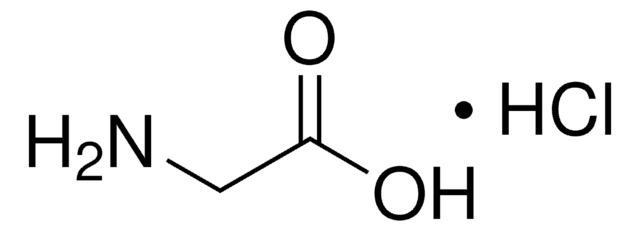G8898
Glycine
≥99%, suitable for western blotting
Synonym(s):
Aminoacetic acid, Aminoethanoic acid, Glycocoll
About This Item
Recommended Products
product name
Glycine, suitable for electrophoresis, ≥99%
Quality Level
Assay
≥99%
form
powder
technique(s)
electrophoresis: suitable
western blot: suitable
impurities
≤0.01% Insoluble matter
color
white to off-white
pKa (25 °C)
(1) 2.35, (2) 9.60
2.35
mp
240 °C (dec.) (lit.)
solubility
H2O: 200 mg/mL, clear, colorless to faintly yellow
anion traces
chloride (Cl-): ≤70 ppm
cation traces
heavy metals (as Pb): ≤20 ppm
absorption
≤0.15 at 280 at 1 M
functional group
amine
carboxylic acid
storage temp.
room temp
SMILES string
NCC(O)=O
InChI
1S/C2H5NO2/c3-1-2(4)5/h1,3H2,(H,4,5)
InChI key
DHMQDGOQFOQNFH-UHFFFAOYSA-N
Gene Information
rat ... Grin2a(24409)
Looking for similar products? Visit Product Comparison Guide
Related Categories
General description
In addition to its biological functions, glycine exhibits versatility in research applications. Its role as a biochemical reagent makes it valuable in assays and procedures, while its buffering capacity is essential in techniques like SDS-PAGE, Western Blotting, chromatography, and cell culture. Glycine′s zwitterionic nature makes it an effective buffer across various pH values, widely used in immunology research for buffer preparation in techniques such as Western Blotting. Compatible with enzymes, glycine is useful in enzymatic assays like lactate determination. Moreover, glycine contributes to buffer formulations for protein stabilization, pH control, and enzymatic reactions.
Application
- Glycine has been used for the preparation of gelatin composites scaffold.
- It has been used in the elution buffer to extract protein using HiTrap protein G column.
- It has been used in the SDS-sample, running and transfer buffers prepared for SDS-PAGE (sodium dodecyl sulfate polyacrylamide gel electrophoresis) and western blotting.
Biochem/physiol Actions
Features and Benefits
- Suitable for Cell Biology and Biochemical studies
- High-quality compound suitable for multiple research applications
Analysis Note
Other Notes
also commonly purchased with this product
comparable product
Storage Class Code
11 - Combustible Solids
WGK
WGK 1
Flash Point(F)
Not applicable
Flash Point(C)
Not applicable
Personal Protective Equipment
Certificates of Analysis (COA)
Search for Certificates of Analysis (COA) by entering the products Lot/Batch Number. Lot and Batch Numbers can be found on a product’s label following the words ‘Lot’ or ‘Batch’.
Already Own This Product?
Find documentation for the products that you have recently purchased in the Document Library.
Customers Also Viewed
Our team of scientists has experience in all areas of research including Life Science, Material Science, Chemical Synthesis, Chromatography, Analytical and many others.
Contact Technical Service







